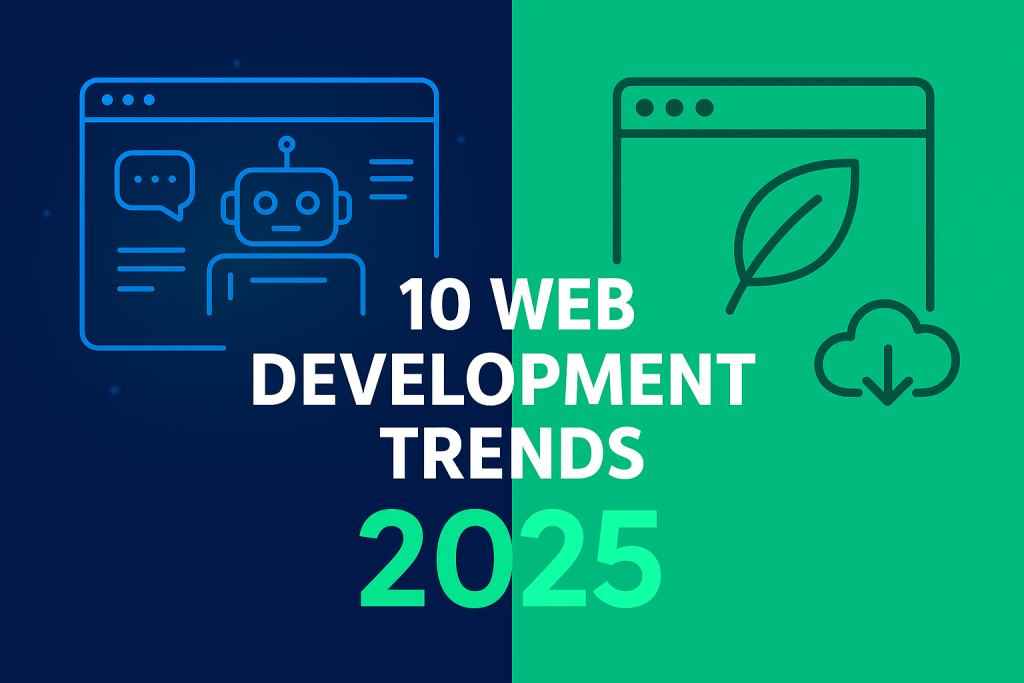
The web moves ridiculously fast. Seriously—blink and you’ve missed three new JavaScript frameworks, another browser update, and yet another heated Twitter thread about whether AI will replace developers or just make us all work weekends.
Whether you’re knee-deep in code, trying to keep your online store afloat, or just curious about where this whole internet thing is headed, keeping up with web development trends feels less like casual reading and more like survival mode.
Right now, what’s shaping 2025 seems to be a perfect storm: users who have zero patience for slow sites, AI that’s actually starting to work (sort of), privacy laws that keep getting stricter, and everyone wanting richer online experiences. The tricky part? Figuring out which web development trends are worth your sanity and which ones are just shiny distractions.
Here are 10 trends that appear to actually matter—and why they might change how you build or experience the web.
1. AI-Powered Web Development Trends (And We’re All Trying to Keep Up)
AI in web development isn’t some distant sci-fi concept anymore. It’s here, and it’s… well, it’s complicated. GitHub Copilot can finish your functions before you’ve fully thought them through, which is both amazing and slightly unsettling. Automated testing tools now catch bugs I didn’t even know I was about to create.
The personalization engines are getting scary good too. Ever notice how that online store seems to know exactly what you want before you do? That’s AI tracking your every click and scroll.
What this really means is that routine coding tasks might become background noise, freeing us up for the stuff that actually requires human thinking—like figuring out why users abandon their shopping carts or making interfaces that don’t make people want to throw their phones. Though I suspect we’ll just end up busier than ever.
2. Progressive Web Apps: Leading Web Development Trends
PWAs have been “the future” for what feels like forever, but they’re finally starting to live up to the hype. Maybe. The idea is simple enough: websites that behave like native apps without all the App Store drama.
Starbucks nailed this with their PWA—you can order your overpriced latte even when your WiFi is acting up, and it syncs everything once you’re back online. Twitter Lite does something similar, loading fast even when you’re stuck with terrible mobile data.
For businesses, this could mean not having to maintain separate iOS and Android apps (which, let’s be honest, is expensive and kind of a nightmare). But whether users actually care about PWAs the way we think they should… that remains to be seen.
3. Voice Search: Web Development Trends Changing Content
“Hey Google, where can I get decent tacos near me right now?” This is how people search now, not by typing “best tacos [city name] 2025” into a search box like we used to.
Voice search is pushing developers to rethink everything. Content needs to sound natural when read aloud. Schema markup matters a lot, especially with voice assistants. These tools aren’t “reading” your site the way a person would; they’re scanning for clues. If your content isn’t clearly marked, there’s a good chance the assistant will miss what you’re actually offering. Think of it like giving directions to someone who’s never been in your neighbourhood, without a map, they’ll probably end up somewhere else. And your site better load fast, nobody’s waiting around when they ask their phone a question.
The predictions about voice search dominating web traffic by 2026 might be overly optimistic, but it’s definitely worth preparing for. Better to be ready than scrambling later.
4. No-Code Platforms in Modern Web Development Trends
This one’s interesting because it challenges the whole “you need to know how to code” assumption. Platforms like Webflow, Bubble, and even the newer versions of Wix are letting people build legitimate websites and apps without touching a single line of code.
I’ve seen small business owners launch entire e-commerce sites in a weekend using these tools. Startups are prototyping ideas in days instead of months. It’s not going to replace custom development for complex projects, but for a lot of basic needs? It’s surprisingly capable.
The downside is that everyone’s using the same templates, so everything starts looking similar. And you’re still locked into whatever the platform decides to support.
5. Serverless Architecture Web Development Trends (When They Work)
Serverless computing might sound like marketing speak, but it’s genuinely becoming one of the more practical web development trends. Instead of managing servers, you just write functions and let AWS Lambda or Google Cloud Functions worry about running them.
The appeal is obvious: no server maintenance, automatic scaling, and you only pay for what you use. When your site suddenly gets featured on Reddit and traffic spikes 1000%, serverless handles it without breaking a sweat (in theory).
The reality is a bit messier. Cold starts can be slow, debugging distributed functions is a pain, and vendor lock-in is real. But when it works well, it really works well.
6. Motion UI: Visual Web Development Trends Done Right
Animation on websites used to mean either boring static pages or seizure-inducing Flash intros. Now we’re finding a middle ground that actually makes sense.
Subtle animations can guide users through your site naturally. A button that gently pulses when you hover over it feels more alive than a static rectangle. Loading animations let people know something’s happening instead of wondering if the site broke.
The key word here is “subtle.” Nobody wants a website that moves more than a carnival ride. But small touches that provide feedback and create flow? Those can genuinely improve the user experience.
7. Security-First Web Development Trends (Because It Has to Be)
Data breaches are so common they barely make headlines anymore, which probably means we should be more worried, not less. Security can’t be an afterthought anymore—it needs to be baked into everything from the start.
HTTPS is now a basic requirement, not a nice-to-have. Multi-factor authentication is becoming standard. Privacy laws like GDPR and CCPA aren’t just European problems anymore; they’re affecting how everyone builds websites.
The challenge is balancing security with usability. Nobody wants to jump through fifteen verification steps to read a blog post, but nobody wants their credit card info stolen either.
8. Web Accessibility in Current Web Development Trends
Making websites accessible used to be seen as extra work for a small audience. That thinking has (finally) shifted. Alt text for images, proper heading structures, keyboard navigation—these aren’t just compliance checkboxes anymore.
Beyond the obvious benefits for users with disabilities, accessibility improvements help everyone. Captions on videos aren’t just for people with hearing impairments—they’re useful when you’re watching something in a noisy coffee shop. High-contrast modes help when you’re squinting at your phone in bright sunlight.
The legal landscape is pushing this too. Accessibility lawsuits are becoming more common, and the costs of retrofitting an inaccessible site are usually much higher than building it right the first time.
9. Blockchain in Web Development Trends Beyond Crypto
Blockchain technology is trying to prove it’s useful for more than just making people rich (or poor) on crypto investments. The underlying technology—tamper-proof records and decentralized verification—has some legitimate applications.
Smart contracts are starting to show up in real business processes. Supply chain tracking is using blockchain to verify that products are actually what they claim to be. Digital identity systems are being built that don’t rely on big tech companies storing all your personal data.
Whether this will live up to the hype remains to be seen. Blockchain solutions tend to be slower and more expensive than traditional databases, so they only make sense when you really need that decentralization and tamper-proofing.
10. AR and VR: Immersive Web Development Trends
Augmented and virtual reality have been “just around the corner” for years, but they’re finally starting to show up in ways that actually make sense for regular websites.
IKEA’s AR furniture placement tool lets you see how that couch would look in your living room before buying it. Real estate sites offer virtual walkthroughs that are genuinely helpful. Some online stores let you “try on” glasses or see how paint colors would look on your walls.
The technology still has limitations—not everyone has AR-capable devices, and VR headsets are still pretty niche. But when implemented thoughtfully for specific use cases, these technologies can create experiences that stick with users way longer than static product photos.
Where These Web Development Trends Lead
The digital world shows no signs of slowing down, and trying to keep up with web development trends can feel overwhelming. Not every trend will pan out—remember when everyone was convinced, we’d all be using QR codes for everything by now?
The key seems to be focusing on web development trends that solve real problems rather than just adding complexity. AI tools that actually save time? Worth exploring. Voice search optimization that helps people find what they need? Probably smart. Blockchain-powered social media platforms? Maybe wait and see.
If you’re planning a website overhaul or thinking about your digital strategy, start with the web development trends that directly address your users’ pain points. The fancy technology is just a means to an end—and that end should always be making people’s lives a little bit easier.


